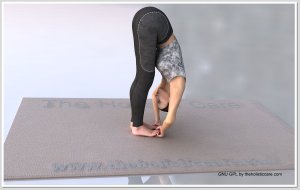 PNF combines passive (relaxed or static stretching) with isometric contractions. PNF as a method for stretching was developed in the 1940’s and 1950’s. It was originally designed to rehabilitate patients suffering from polio induced paralysis. By the late 1970’s, athletes were using PNF to improve flexibility.
PNF combines passive (relaxed or static stretching) with isometric contractions. PNF as a method for stretching was developed in the 1940’s and 1950’s. It was originally designed to rehabilitate patients suffering from polio induced paralysis. By the late 1970’s, athletes were using PNF to improve flexibility.
My first encounter with PNF came during a stretching session in our TKD class. Larry, a much more advanced student was helping me with a basic hamstring stretch. I was on my back with one straight leg raised and the other flat on the floor. Larry was gently pressing the raised leg back towards my shoulder, while I relaxed. When we reached the limit of the stretch, Larry asked me to press my leg against his shoulder and try to push him back. As I flexed my hamstring, he leaned against the leg, so that neither of us actually moved, while my hamstring contracted. After 10s, he told me to relax again. He gently stretched the leg while I was relaxing and it moved past the initial stopping point. When he did this on the other side, the same effect was achieved.
The Myotatic Reflex
To protect themselves from injury, muscles have a built in reflex called the myotatic reflex or stretch reflex. As a muscle lengthens, it sends out signals along the nerves to the spinal cord. If the muscle lengthens too far or too fast or both, an input signal is sent back to the muscle directing it to contract and protect itself. This forms a nice feedback loop. As you reach the end of your lengthening stretch for the hamstring, signals come back to contract the muscle and protect it from over stretching.
You can change the point where this return signal is fired. By holding a static stretch you are getting your muscle comfortable with the new length and recalibrating the point where the muscle feels threatened.
The Golgi Complex
Muscles also have a feedback mechanism for protecting themselves due to excessive contraction. Anyone who has had a dramatic failure on a max lift attempt is familiar with this reflex. The Golgi tendon organ is a part of the muscle that measures the tension of muscles as they contract. As the tension builds, the Golgi tendon organ sends signals to the spinal cord. If the tension becomes too high, then to protect the muscle, a feedback signal is sent directing the muscle to relax.
hacking the system
By introducing isometric tension, you override the contract reflex and substitute the relax reflex, allowing for a deeper stretch. Exercise extreme caution when performing this type of stretching. The body has these protective mechanisms in place for good reason.
If you want to experiment with PNF, try the following hamstring stretch. Stand up straight, legs shoulder width apart. Relax and bend at the waist. Keep your legs straight, but let your muscles relax. Slowly count to 30. After 30s stretching this way, make two fists and tense your muscles: glutes, hamstrings, calves and squeeze your fists to tense your upper body. Hold for 10s. Take shallow breaths during the 10s of tension. At the end of 10s, exhale and relax, dropping deeper into the original stretch. If you still feel comfortable, tense a second time, then exhale and relax the muscles.
If you have success using PNF with this stretch, then consider experimenting with using this protocol for other stretches.








